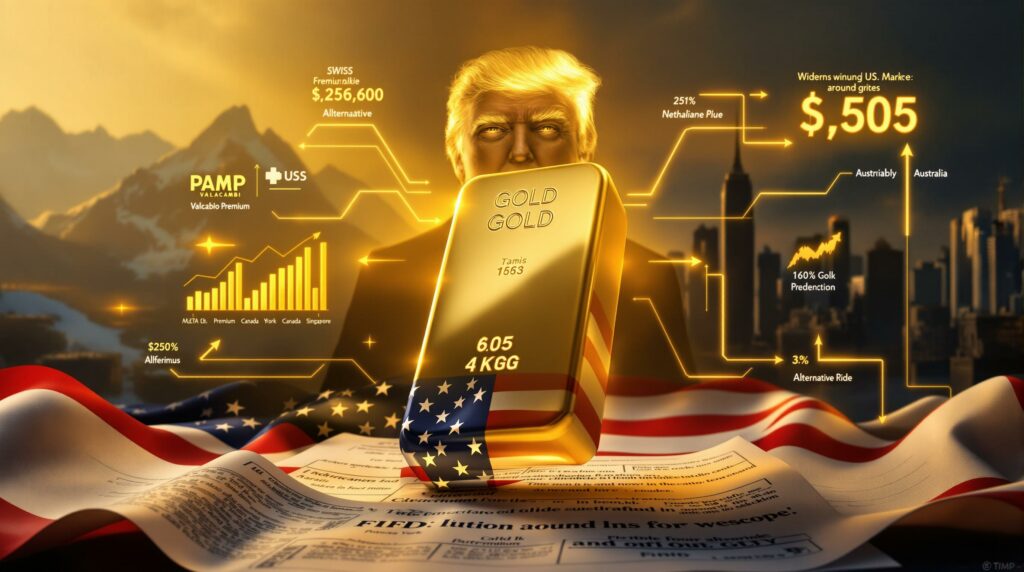US Hits Gold Bars with Tariffs in Blow to Switzerland
The US government's recent decision to impose tariffs on one-kilogram gold bars has created significant ripples across global bullion markets, particularly impacting Switzerland's gold trade. This unexpected policy shift threatens to reshape international gold trading patterns and pricing structures, with immediate effects already visible in market premiums and trading relationships. The move comes as all-time high gold prices were already creating volatility in precious metals markets.
Understanding the New Gold Bar Tariffs
The tariff implementation came as a surprise to many industry participants who had anticipated gold bars would fall under customs codes exempt from President Trump's broader country tariff program. According to a July 31, 2025 ruling letter from US Customs and Border Protection, both one-kilogram and 100-ounce gold bars have been classified under codes subject to these new levies.
This classification decision is particularly significant because:
- One-kilogram bars represent the most commonly traded format on Comex, the world's largest gold futures marketplace
- These bars constitute the majority of Switzerland's gold exports to the United States
- The ruling creates immediate pricing disparities between US and global markets
The gold market was caught off guard by this regulatory change, as most industry experts had believed precious metals would remain exempt from the broader tariff program due to their status as monetary assets and financial instruments. According to The Financial Times, the decision has unleashed new turmoil in precious metals trading.
What Immediate Market Reactions Have Occurred?
Price Premium Spikes
The market response to the tariff announcement was swift and dramatic. As Asian markets opened following the news, gold futures contracts for December delivery jumped to more than $100 per ounce above the global benchmark spot price in London.
This widening premium reflects traders' expectations of reduced physical gold availability in US markets. When physical delivery becomes more difficult or expensive, futures prices typically disconnect from spot prices, creating what traders call a "contango" situation.
"The market is pricing in the increased cost and complexity of delivering gold to satisfy futures contracts," notes a senior precious metals strategist at a leading US financial institution. "This $100 premium represents both the tariff costs and the uncertainty around future physical flows."
The price differential creates arbitrage opportunities but also introduces new complications for market participants, especially those who had established trading patterns based on the historical relationship between US and international gold prices. The gold market performance has been significantly altered by these new trade barriers.
Trading Volume Adjustments
Market data indicates significant shifts in trading patterns following the announcement:
- Increased activity in alternative gold contract sizes not affected by the tariffs
- Growing interest in non-Swiss gold bar imports from countries not subject to the same tariff treatment
- Repositioning by major bullion banks to adjust inventory management strategies
- Higher volatility in normally stable gold leasing and lending markets
These adjustments reflect the market's attempt to find equilibrium under the new regulatory environment, with participants scrambling to identify the most cost-effective ways to maintain gold flows into the US market.
Why Is Switzerland Particularly Affected?
Switzerland's Dominant Gold Market Position
Switzerland holds a uniquely important position in global gold markets that makes it especially vulnerable to these tariffs:
- The country serves as the world's primary gold refining hub
- Swiss refineries process approximately 70% of the world's annual global gold production
- The country maintains stringent quality standards that have made Swiss gold bars the industry benchmark
- Major Swiss refiners like PAMP, Valcambi, and Metalor have established global reputations for quality assurance
This concentration of refining expertise has evolved over centuries, with Switzerland's political neutrality, banking secrecy, and metallurgical expertise creating perfect conditions for the gold industry to flourish.
Trade Flow Disruptions
The tariffs create specific challenges for Swiss-US gold trade:
- Switzerland exports billions in gold products to the US annually
- The country's refineries specialize in producing the exact bar sizes now targeted by tariffs
- Established supply chains between Swiss refiners and US bullion dealers face potential restructuring
- Just-in-time inventory systems for gold-dependent industries may require reconfiguration
The timing of these tariffs is particularly challenging for the Swiss gold industry, which has already been navigating increased regulatory scrutiny around sourcing practices and sustainability. According to Reuters, some bullion shipments to the US have already been halted while traders await clarification.
How Might Global Gold Trading Patterns Change?
Alternative Sourcing Strategies
US gold importers are likely to explore several options to adapt to the new tariff environment:
- Shifting procurement to non-tariffed countries with significant refining capacity
- Increasing imports of different gold product formats not covered by the tariffs
- Developing domestic refining capabilities to process gold doré (semi-pure gold) directly
- Creating new supply chain models that minimize tariff exposure
Some industry analysts suggest Canada and Australia could be primary beneficiaries of this shift, as both nations have substantial gold production, established refining infrastructure, and favorable trade relationships with the United States.
Market Segmentation Possibilities
The global gold market may experience increased fragmentation:
- Price differentials between US and international markets could become more persistent
- Regional gold trading hubs might gain importance relative to traditional centers
- New arbitrage strategies could emerge to capitalize on price discrepancies
- Exchange-traded products may need to adjust their physical backing strategies
This potential fragmentation represents a significant shift for a market that has historically functioned as a highly integrated global system with minimal regional price variations. The current gold price forecast will need to be reassessed in light of these structural changes.
What Are the Broader Economic Implications?
Investment Market Considerations
The tariffs introduce several factors for gold investors to consider:
- Potential increases in physical gold premiums for US buyers
- Complications for ETFs and investment products that rely on physical gold backing
- Possible impacts on gold's role as a safe-haven asset during economic uncertainty
- New considerations for portfolio diversification strategies that include precious metals
For institutional investors, these changes may require reexamining asset allocation models that incorporate gold as an inflation hedge or portfolio diversifier. The tariffs' market impact extends well beyond gold to affect broader investment strategies.
Industrial and Jewelry Sector Effects
Beyond investment markets, other gold-consuming sectors may experience impacts:
- Electronics manufacturers using gold components may face increased input costs
- Jewelry producers might adjust sourcing strategies or pass costs to consumers
- Dental and medical applications of gold could see modest price increases
- Specialized industrial uses in aerospace and other sectors may require supply chain adjustments
The jewelry industry, which accounts for approximately 50% of annual gold demand, may be particularly affected if price disparities persist between major consumption markets.
How Might Switzerland and Other Nations Respond?
Diplomatic and Trade Negotiations
Several potential responses from affected nations could emerge:
- Switzerland may pursue bilateral discussions to seek exemptions for gold products
- Industry associations might lobby for reclassification of specific gold bar formats
- Trade organizations could file formal challenges through international trade bodies
- Affected nations might consider reciprocal measures on US exports
Switzerland's historical diplomatic neutrality puts it in a complex position when navigating trade disputes, potentially limiting its retaliatory options compared to other trading partners.
Industry Adaptation Strategies
Gold market participants are likely to implement various adjustments:
- Swiss refiners might modify product offerings to target non-tariffed categories
- Development of alternative delivery locations for futures contracts
- Creation of new financial instruments to hedge tariff-related price risks
- Investment in technological solutions to maintain competitiveness despite tariff headwinds
The gold industry has demonstrated remarkable adaptability throughout its long history, suggesting market participants will find ways to maintain efficient trade flows despite regulatory changes.
What Does This Mean for Gold Prices Going Forward?
Short-Term Price Implications
The immediate market effects include:
- Widened spreads between physical and paper gold markets
- Increased volatility in gold futures contracts
- Higher transaction costs for certain market participants
- Potential premium spikes during delivery months on futures exchanges
These effects may create both challenges and opportunities for various market participants, from physical traders to speculative investors.
Long-Term Market Structural Changes
Over time, the gold market may undergo more fundamental adjustments:
- Potential shifts in global gold refining capacity distribution
- Evolution of standard trading unit sizes in response to tariff structures
- Reassessment of Switzerland's central role in international gold markets
- Development of new financial instruments to manage tariff-related risks
While gold's fundamental value proposition as a store of wealth remains unchanged, the mechanisms through which it trades and the associated costs may evolve significantly.
FAQs About US Gold Bar Tariffs
Which specific gold bar formats are affected by the new tariffs?
The US Customs and Border Protection ruling specifically targets one-kilogram (32.15 troy ounces) and 100-ounce gold bars. Other formats, including smaller investment bars and coins, appear to remain unaffected under current classifications. This specificity creates opportunities for market participants to adjust product specifications to avoid tariff exposure.
How do these tariffs affect gold ETFs and investment products?
Gold ETFs and similar investment vehicles that hold physical gold as backing may face increased acquisition costs if they rely on the affected bar formats. This could potentially impact expense ratios or tracking precision relative to spot gold prices. Some ETF providers may need to adjust their physical gold storage strategies or diversify their bar holdings to minimize tariff impacts.
Could these tariffs lead to increased gold smuggling or illicit trade?
Any significant price differential between markets can create incentives for circumvention. Industry experts suggest enhanced due diligence and supply chain verification will be crucial to maintain market integrity under the new tariff regime. Historically, gold has been susceptible to smuggling during periods of trade restrictions or significant price disparities between regions.
Will these tariffs affect consumer gold prices in the US?
Retail consumers may eventually see modest price increases for gold investment products, though the impact will likely be most pronounced in wholesale markets dealing with the specific tariffed formats. Consumer-oriented products like small bars and coins may see secondary price effects as overall market dynamics adjust.
Could other countries benefit from Switzerland's potential market share loss?
Nations with established gold refining infrastructure—such as Australia, Canada, and Singapore—may gain competitive advantages if Swiss gold exports to the US decline significantly. These countries could potentially expand their refining capacity and develop more robust trading relationships with US market participants seeking to minimize tariff exposure.
Disclaimer: The gold market is subject to significant volatility and regulatory change. The information presented here is based on current understanding of the tariff situation as of August 2025. Investors should consult financial professionals before making investment decisions based on tariff implications.
Looking for the Next Major Gold Investment Opportunity?
Stay ahead of the market with Discovery Alert's proprietary Discovery IQ model, which instantly notifies investors about significant ASX mineral discoveries, including gold opportunities that could rival the gains seen in historic discoveries. Learn why major mineral discoveries can lead to substantial returns by visiting Discovery Alert's dedicated discoveries page.




